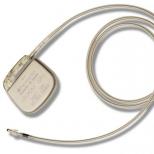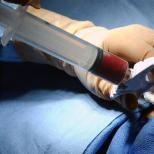Electrocardiography technology
1. It is necessary to explain to the patient in advance its painlessness.
3. It is necessary to take an ECG after a 10-15 minute rest (resting state), i.e. before the examination, it is better to sit quietly, read a book, etc., but you should not run along the corridor or up the stairs (otherwise, on the ECG instead of the ECG at rest, there will be a result, as after physical exertion, which can be misinterpreted when deciphering)
4. If the patient is restless, then the recording may be distorted. Therefore, competent medical staff tries to comply with the requirements.
5. If the patient took any medications in the morning (especially cardiovascular drugs), warn the medical staff to make a mark on the ECG, this will help the doctor when deciphering
6. If you have previously made ECGs on hand, it is better to take them with you so that when decoding the Electrocardiogram, the doctor can assess the dynamics.
7. ECG is recorded in a thermal room, remote from possible sources of electrical interference, after 10-15 minutes of the patient's rest, not earlier than 2 hours after eating.
8. An ECG recording is usually carried out with the patient lying on his back with maximum muscle relaxation and calm, shallow breathing.
EQUIPMENT: electrocardiograph; couch; disposable wipes; containers with disinfectant solutions.
PREPARATION FOR THE STUDY:
Install the electrocardiograph and the couch in a comfortable position away from possible sources of electrical interference at a distance of at least 1.5 - 2 m from the mains wires,
The room should be warm (to avoid trembling of the patient), dry and bright,
The study is carried out after 10-15 minutes of rest, not earlier than 2 hours after eating,
Invite the patient to undress to the waist and release the shins from clothing, offer to take a horizontal position on the couch lying on his back, achieve maximum muscle relaxation,
Fill the electrocardiograph with special thermal paper,
Connect the device to a special ground loop bus, grounding through water supply and heating pipes and serial grounding of devices is unacceptable, an electrocardiograph with an autonomous power source does not require grounding,
Connect the power cable to an AC outlet with a nominal voltage of 220 V,
Fix the electrodes on the inner surface of the limbs: on the forearms above the wrist, on the shins above the ankle; in the absence of a limb, its part, or in the presence of a bandage, apply the electrodes to the most distal available (open from the bandage) segment of the limb, and on a healthy limb - symmetrically to it,
Ensure good contact of the electrodes with the skin to improve the quality of the ECG recording, use disposable wipes:
Pre-degrease the skin with alcohol in the places where the electrodes are applied,
Moisten the electrode sites with isotonic or 5-10% sodium chloride solution or apply electrode paste,
With significant hairiness of the skin, moisten with soapy water,
Connect the wires of the lead cable to the electrodes on the limbs in the following order in accordance with the generally accepted marking of the input wires:
Red - on the right hand,
Yellow - on the left hand,
Green - on the left leg,
Black is on the right leg.
These electrodes will record standard ECG leads, denoted by Roman numerals: I, II, III; as well as reinforced from the limbs: aVR, aVL, aVF.
Place 6 chest electrodes in the form of rubber bulbs at certain points on the patient's chest in the intercostal spaces, ensure good contact of the electrodes with the skin (see above) and connect the cable wires in accordance with the marking as follows:
V1 - red electrode - IV intercostal space at the right edge of the sternum,
V2 - yellow - IV intercostal space at the left edge of the sternum,
V3 - green - in the center between V2 and V4,
V4 - brown - in the 5th intercostal space along the mid-clavicular line,
V5 - black - along the same horizontal line along the anterior axillary line,
V6 - purple - along the same horizontal line along the mid-axillary line.
These electrodes will give a recording of Wilson's unipolar chest leads.
RESEARCH PERFORMANCE:
1. turn on the electrocardiograph by pressing the power button,
2. register a calibration millivolt - a control pulse with an amplitude of 1 mV equal to 10 mm,
3. to record an ECG in 12 leads in turn, in each lead for at least 4 cardiac cycles (PQRST), at a paper speed of 50 mm / s, use a lower speed of 25 mm / s for rhythm disturbances,
4. ECG recording should be carried out with calm, shallow breathing, lead III is also recorded when holding the breath on inspiration; in the presence of interference, recording can be done while holding the breath; in case of severe shortness of breath in a patient, an ECG recording should be performed in a semi-sitting position,
5. During recording, the patient should not touch the body of the electrocardiograph, and the operator should not touch the patient and the machine at the same time.
COMPLETION OF THE STUDY:
Turn off the electrocardiograph,
Release the patient from the electrodes, allow him to get up and leave the office,
On the ECG film, write down the patient's full name, age, date of examination, if necessary, indicate the sex (male, female), if it is not clear from the surname, mark the leads on the film,
Treat the electrodes: soak in a 3% hydrogen peroxide solution with the addition of 0.5% detergent for 60 minutes, rinse with running drinking water and dry,
Wipe the surface of the device twice with 70% alcohol,
Soak used disposable wipes in a disinfectant solution in accordance with the instructions and dispose of,
Treat hands in a social (domestic) way,
To decipher the ECG, draw up a protocol and conclusion, register the conclusion in the journal, register the patient in the alphabetical journal, place the ECG in the archive, if necessary, hand it over to the treating doctor .
Rice. Points of chest assignments of an ECG.

Rice. Formation of three standard leads





